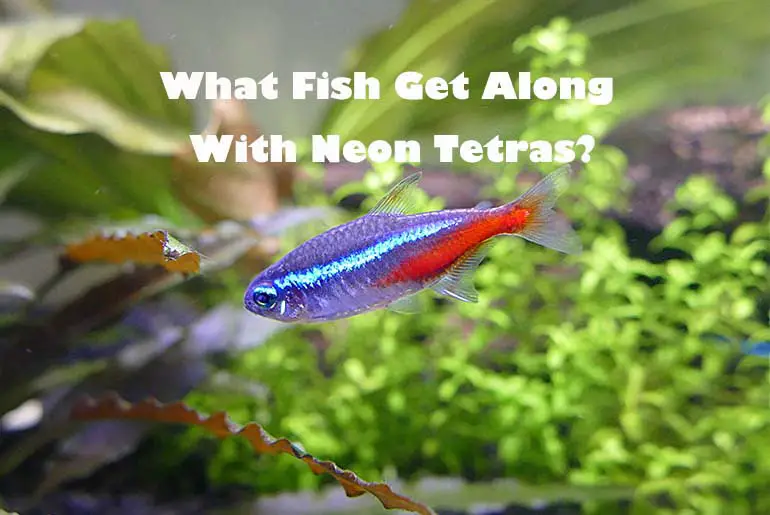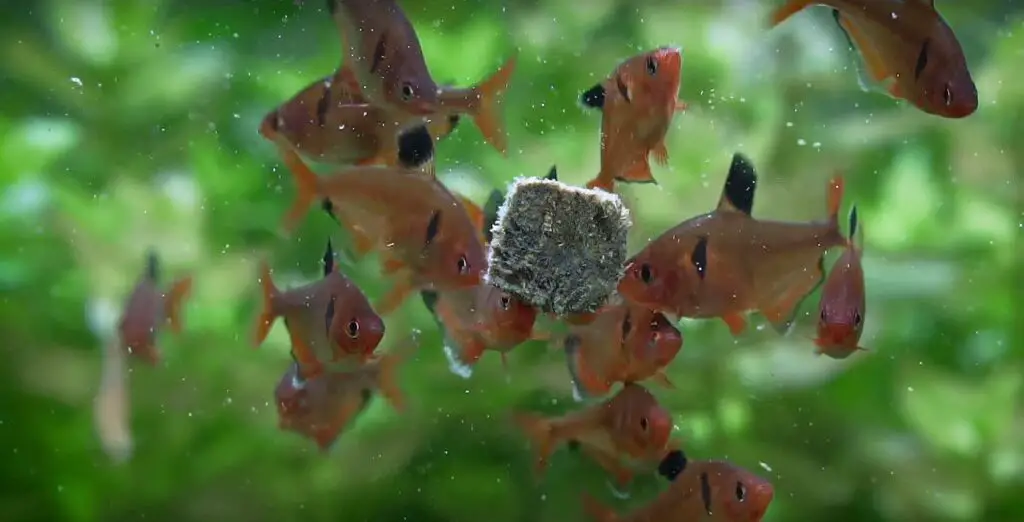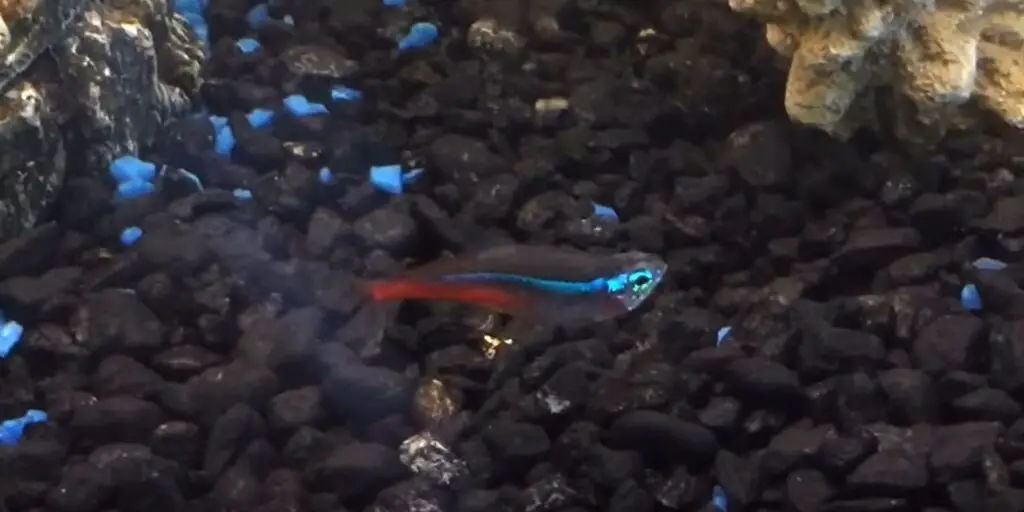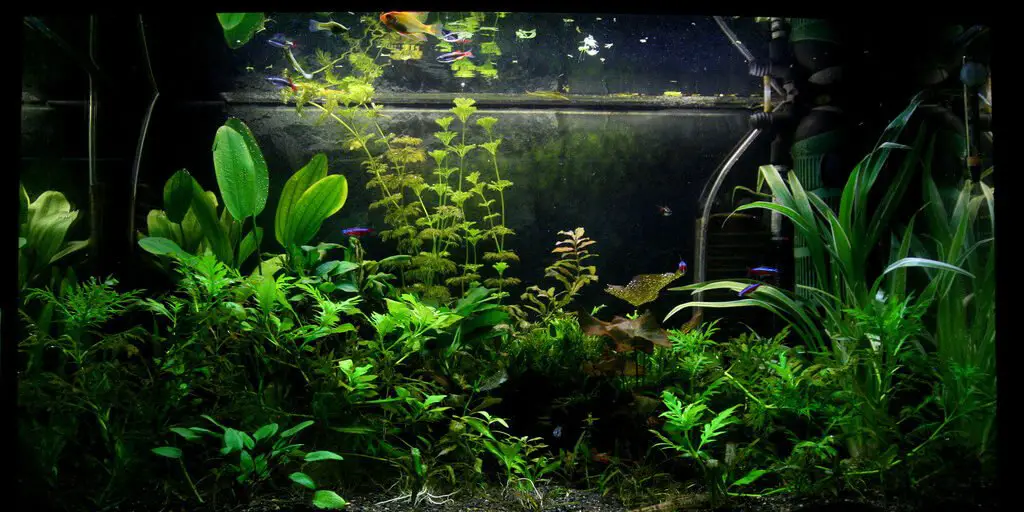Neon Tetras are small, colorful, and vibrant fishes. They are tropical fishes and are natives of South America. Since these tropical fishes make the aquarium beautiful and lively, they are often referred to as “jewels of the aquarium”. They are both schooling and shoaling fish. These tiny fish have a peaceful temperament and are easy to keep. But they are also fragile and can succumb to various small reasons. Neon Tetras can live up to 10 years in their wild form, but in their captive form, they make up to 8 years at most. In this article, I will try to explain to you why your neon tetras are dying.
The major cause of deaths of neon tetras is the change in water parameters and insecurity. Neon Tetras are shoaling fishes and they stay together in groups. When there are only a few neon tetras kept together, they become stressed and die. Also, neon tetras cannot resist sudden changes in water parameters and die eventually. Besides, neon tetras can also succumb to various bacterial infections and neon tetra disease.
Reasons Why Neon Tetras Die
Many people often find it troublesome to keep tetras, because neon tetras are very sensitive and a little effort must be given to them to keep them alive. The Lifespan of Neon Tetra – How Long Does a Neon Tetra Live For? New fish keepers often face this problem as their neon tetras die easily. Here are some reasons why neon tetras die:
Water Parameters
For these little tropical fishes, the PH, KH, GH, and temperature must be in exact range.
Related articles:
- Water Parameters for Tetra Fish: Stable Water Condition
- Increase the pH of Your Freshwater Aquarium
- Does Water pH Level Affect Neon Tetras?
PH, KH, GH
When the pH level of aquarium water is high, the neon tetras tend to die, the pH level of more than 7 is considered hazardous for tetras. Too much of KH or too less of it is harmful to neon tetras as well. GH measures if the salts and minerals are adequate in water. The GH level in neon tetras must be below 10 i.e the water should not be hard.
Temperature
Neon tetras are tropical fishes. So, it is pretty clear that they cannot survive in cold temperatures.
You would better check the temperature time and again. But, considering their origin is from a warm place, the water temperature of aquariums must not be too warm either. The more the temperature the less is the oxygen. So the temperature between 72 to 78℉ is considered ideal water temperature for Neon Tetras.
Related articles:
- Are Tetra Tropical Fish? Tetra Origin and Habitat.
- Can Neon tetra survive in cold water?
- Are Tetras cold water fish?
- What is the maximum water temperature for neon tetras?
Ammonia Level
When we neglect the cleanliness of the tank, it results in the presence of ammonia in aquariums. Ammonia is lethal to neon tetras. Excess food, dead fishes, excreta of fishes, etc releases bacterias.
Those bacterias make the water toxic due to the formation of ammonia, which ultimately causes the death of neon tetras.
Related articles:
Insecurities
Neon tetras are shoaling fishes and they should be kept in schools. When neon tetras do not find a lot of their friends around, they become insecure and stressed.
This also results in their aggressive behavior like biting other neon tetras fins. So this is one of the major causes of the demise of these fishes. Many fishkeepers initially just bring 2 or 3 of neon tetras, to fulfill their fishkeeping hobby, but this does not just work. The school of 6 neon tetras is the absolute minimum.
Many tiny fishes naturally stay in groups so that other big fishes do not attack them. Also staying in a group makes them easier to travel.
Related articles:
- Are Tetras Fin Nippers? Are They Aggressive?
- Are Tetras Aggressive – List Of Aggressive Tetra Fish
- Are Tetras Schooling Fish? – Easy Schooling Fish
Bad Genetics
You may not be surprised to know that almost 2 million neon tetras are sold every month, for home aquariums. People prefer neon tetras worldwide! So many people rear neon tetras for selling purposes and they breed the neon tetras in huge amounts.
These people reproduce neon tetras in large fish farms. Neon tetras are produced in such a big amount that people even do not have time to count the fish, they simply weigh them. During this crazy process, the check for quality is almost null.
Hence, we can even see deformities like bent spines in these fish. So, some neon tetras can’t survive for long because they simply have bad genes.
Common Illnesses
Neon Tetras are very sensitive and they are prone to dying. Even common fish illnesses prove to be lethal for these little fish. Various bacterias can cause diseases like fin rots and bacterial infection in neon tetras.
In this situation, the fins start to lose color and even open wounds are visible on the edge of their fins. Internal parasites can also kill the neon tetras, this disease is least common but due to some food we feed neon tetras can cause worms on their stomach.
Related articles:
- Tetra Fish Diet | What do Tetra Fish Eat: A Complete Guide
- Do Tetra Fish Eat Algae? – Should You Add Algae To Their Diet?
- Best Neon Tetra Homemade Foods: How To Make And Feed
- Can Neon Tetra Eat Goldfish Flakes?
- Why Is My Neon Tetra Not Eating? – Here Is What You Can Do
Neon Tetra Disease(NTD)
Have you noticed neon tetras with tumors or cysts in various parts of their body? Did they also lose the color of their body? Well, in that case, the neon tetras may have caught the neon tetra disease.
This disease starts with mild symptoms and worsens over time. The neon tetra disease is caused by a parasite named Pleistophora Hyphessobryconis. This parasite feeds on the host until the host dies.
In severe cases, we can notice crooked spines in the neon tetras, which even makes these fishes difficult to swim.
The neon tetras catch this disease when they eat infected live foods or they come in contact with other infected fishes. This disease is highly contagious.
There is no proven solution for this disease, so one must quarantine the infected fish as soon as they discover it.
Get more information on Growth on Neon Tetra’s Mouth | Cause And Treatment from here.
High Stress
Stress in neon tetras can occur due to various reasons. Like we humans get stress when we see messy environments, have sour relationships with family and peers, etc. It is the same with fishes as well.
Fish can be stressed when they do not get proper water conditions or even when other big fish bully them or they can’t make other fishes their friends.
Swimming in different patterns, losing appetite, ich and other diseases, or gasping at the top surface are some symptoms that the neon tetras are stressed.
Other Fishes Eat Them
Neon Tetras only grow up to 1.5 inches i.e they are small. While setting up an aquarium, you may prefer other various fish along with neon tetras. Sometimes larger fishes may bully or attack the neon tetras.
Bullying results in the faded color of tetras, also the neon tetras do not swim in their school. It causes stress initially and death ultimately.
Larger fish can bite them and rip them off, which kills neon tetras eventually.
What Are Symptoms Of Dying Neon Tetras?
When you know what a dying neon tetra looks like, you may be willing to help it in each possible way you can. So, let us take a glance at the symptoms of dying neon tetras:
Abnormal Swimming Patterns
Sick neon tetras often show abnormal swimming patterns. When you normally spend some time of your day looking at the neon tetras, you can figure out if they are showing abnormal swimming patterns. These irregular patterns indicate that the fishes are stressed and maybe dying soon.
Normal neon tetras swim around the aquarium in uniform flow, but the dying neon tetras may have jerks or twitches as they swim. They swim in circles and also flicker as they swim.
You can observe the pattern for 24 hours. If it continues, quarantine the fish. So that the other fish do not catch the same infection.
We know that sick neon tetras are quite difficult to treat. So preventing tetras from disease is the best thing you can do.
Can’t Raise Or Go Down The Water
Most of the neon tetras are middle-level swimmers, however, they can go to the bottom or top to consume food. When you notice neon tetras are just moving at the bottom of the aquarium, this may be a sign of danger.
Also, in some instances, you may find the neon tetras swimming at the top level of water only because they can’t or do not want to move down.
In this case, you should take the fish out and keep them in a separate tank or bowl and quarantine it for a day. If the fish starts swimming normally, then you can keep it back in the aquarium.
But, if the fish does not swim normally, you should diagnose the problem with the neon tetras and treat them immediately.
Related article:
Restlessness
Restlessness is the state where the neon tetras cannot remain calm or relaxed.
This state is also a criterion for the ill health of neon tetras. When the neon tetras cannot adapt to the tank environment, they display restlessness.
When neon tetras are introduced to the tanks for the first time they may experience “shock”.
So they may seem restless. Instead of pouring all the fishes directly into the tank, it is better to let the new bag of neon tetras just float in the aquarium at first. Then periodically let the tank water to enter the bag. And finally, releasing the fishes into the water.
The neon tetras become restless when they are ill as well, so it is necessary to know if the fish is experiencing shock or demonstrating its health status. Check out how to care for neon tetras!
How Can I Prevent My Neon Tetras From Dying?
Though Neon Tetras can only live to a maximum of 8 years in captivity, one reared you would want it to live up to its whole life.
Prevention is better than cure, the best way to prevent neon tetras from dying is to prevent neon tetras from catching any sort of disease or infection. Treating them is the secondary thing.
We suggest a few ways to keep neon tetras healthy and prevent them from dying. But you must first identify your problem and apply appropriate solutions to it.
Applying inappropriate solutions can deteriorate the health of neon tetras even more. Hence, few solutions can prevent your neon tetras from dying. Some of them are:
Maintain Proper Water Parameters
Maintaining stable and proper water parameters for neon tetras is a must. Water parameters play a vital role in the health and lifespan of the neon tetras. So, you should measure the pH, GH, KH, ammonia, temperature, chlorine, etc present in the tank frequently.
- The pH level should be 6 to 7
- The KH level should be between 1 to 2 DKH
- The GH level should be between 10 DGH
- The appropriate temperature is 72℉ to 78℉
- Ammonia and chlorine should not be present at all.
Keep Neon Tetras In School
Neon Tetras are social fishes and they can be stressed out when they are kept alone or in a few numbers. So keeping the minimum of six neon tetras in at least a 10-gallon tank is the absolute minimum. But I recommend you keeping 10 neon tetras at least in a 15-gallon tank.
Aqua Culture 10 Gallon Aquarium Starter Kit is the best 10 gallons tank in the market. It is quite affordable and qualitative which is perfect reason to buy an aquarium.
The more the neon tetras, the more beautiful your aquarium looks. Also, when the neon tetras have a lot more space to roam, they do not tend to be stressed.
So when you do not find your neon tetras contracting any diseases but dying, then you must direct your attention towards the number of neon tetras in the aquarium.
Give Proper Diet
Neon Tetras are vulnerable little fishes. It is very hard to cure them once they contract some diseases or infections. If we can strengthen their immune system, it can help neon tetras to fight diseases and bacterial infections.
Also they block neon tetras from catching diseases easily.
We are familiar that neon tetras should not be fed a huge amount at once, instead, they should be fed a little amount but frequently.
Neon tetras are omnivores, you can include nutritious foods like dried blood worms, pellets, algae, brine shrimps, etc in their daily diet.
Also, low oxygen can lead to low immunity in neon tetras. Subsequently, small infections can also kill the neon tetras.
For oxygen supply, you can aquascape live plants. Live plants can also help by absorbing ammonia and other toxic chemicals. Check out more on ‘Do neon tetras need an air pump?’.
Neon Tetras should be fed 2 to 3 times a day. And each feeding should only last from 1 to 2 minutes.
Aquarium Cycle
The neon tetra aquarium should be cleaned often. Even before adding the new neon tetras, you should cycle the aquarium. First, you will need to buy a “testing kit” so that you can measure pH, KH, GH, and ammonia levels in the aquarium. API Aquarium Test Kit does a brilliant job for such matters.
Before bringing the new neon tetras home, make sure you check how long it takes for ammonia to break into nitrates and nitrites. You need to spare at least 2 weeks before adding new neon tetras in a new tank. So that you can know how frequently you need to cycle the tank.
The nitrogen cycle is the process of converting ammonia into nitrate and nitrite. Excess fish food, feces of fishes, dead neon tetras (if they are kept for long), etc can produce ammonia.
Ammonia is fatal for neon tetras. Ammonia and nitrite should be 0 ppm, whereas nitrate can be less than 20ppm. It is advisable to change 1/4th of the water of neon tetra aquarium each week.
Quarantine Ill Neon Tetras
I know you are already aware that various bacterial infections and the Neon Tetra Disease is very much communicable and contagious to other neon tetras in the tank as well. So, as soon as you notice abnormalities in the behavior of neon tetra, without any delay quarantine the neon tetra.
Do not wait for other neon tetras to develop similar symptoms so that you become sure there is something wrong with the fishes.
One ill neon tetra can swipe away all the neon tetra in the tank if it is not quarantined timely. So quarantine neon tetras as soon as you discover any abnormalities or symptoms of ill neon tetras.
Can I Add New Neon Tetras To Existing Neon Tetra Tanks?
Are you bewildered whether or not to add newly purchased neon tetras in the existing neon tetra tanks? You know well that neon tetras should be kept in cycled tanks but adding new fish to existing tank; is it good?
Well, that is a bad idea. We do not know if the new fishes are healthy or not. Sometimes, even the neon tetras purchased from trusted aquarists can be unwell.
When mixed with our well set up tank, those new fishes can even infect our existing neon tetras.
Therefore, you need to quarantine the new neon tetras for at least a couple of weeks. This can prevent our existing neon tetras from catching bacterial infections and the deadly Neon Tetra Disease.
Last Words
The beautiful looking, vibrant blue and red-colored neon tetras are easy to keep and quite difficult to keep at the same time. If you take care of the water parameters, diet, and nitrogen cycle, the neon tetras can live their full life in your aquarium.
Once you keep them in an aquarium, you become attached to the neon tetras somehow. So, you become stressed or tensed when neon tetras become unwell or start to die.
Foremost, do not let any neon tetras catch disease or infection and give them a proper environment to live. Secondly, isolate and treat neon tetras as soon as you suspect something is wrong. Consider the above guide. Happy fishkeeping!!
Also Read:
- What do neon tetras need in their tank?
- Why do neon tetras die after laying eggs?
- 10 reasons why neon tetras are the perfect pet




